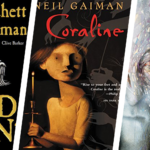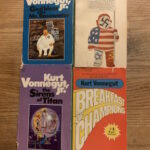Where To Start With Murakami
1. “Norwegian Wood” (1987): This novel is a great introduction to Murakami’s writing style and themes of love, loss, and nostalgia.
2. “Kafka on the Shore” (2002): This surreal and thought-provoking novel follows two parallel narratives, blending reality and fantasy.
3. “The Wind-Up Bird Chronicle” (1994-1995): A complex and enigmatic tale that explores themes like identity, loneliness, and the impact of the past on the present.
4. “1Q84” (2009-2010): This epic novel spans three volumes and delves into alternate realities, cults, and the power of storytelling.
5. “A Wild Sheep Chase” (1982): The third book in the “Trilogy of the Rat,” it combines elements of mystery, fantasy, and social critique.
6. “Hard-Boiled Wonderland and the End of the World” (1985): A dystopian tale that juxtaposes two interconnected narratives and addresses themes of memory, consciousness, and reality.
7. “After Dark” (2004): Set during the late-night hours, this atmospheric novel follows different characters whose paths cross and explores the mysteries of Tokyo’s after-dark world.
8. “Colorless Tsukuru Tazaki and His Years of Pilgrimage” (2013): The story of a man searching for answers about why he was rejected by his old group of friends, this book focuses on themes of identity, loss, and acceptance.
9. “Sputnik Sweetheart” (1999): This novel explores themes of unrequited love, identity, and parallel universes through the story of three characters connected by their longing for someone.
10. “Dance Dance Dance” (1988): The fourth book in the “Trilogy of the Rat,” it follows the protagonist as he explores a mysterious hotel and searches for a missing woman.
11. “South of the Border, West of the Sun” (1992): A tale of lost love and regret, this novel delves into the complexities of relationships and the nostalgia of missed opportunities.
12. “Men Without Women” (2014): A collection of short stories that delve into the lives of men who have lost the women in their lives, covering themes of loneliness, longing, and introspection.
13. “The Elephant Vanishes” (1993): Another collection of short stories showcasing Murakami’s skill in blending the ordinary with the bizarre, often exploring themes of isolation and disillusionment.
14. “Pinball, 1973” (1973): The second book in the “Trilogy of the Rat,” it follows the protagonist’s search for a missing pinball machine while reflecting on youth, freedom, and nostalgia.
15. “Hear the Wind Sing” (1979): The first book in the “Trilogy of the Rat,” it introduces the reader to Murakami’s early writing style and themes of youth, love, and melancholy.
16. “A Hard-Boiled Wonderland and Other Stories” (1980-1991): A collection of short stories showcasing Murakami’s versatility and exploration of various themes, including chance, identity, and human connection.
17. “Blind Willow, Sleeping Woman” (2006): Another collection of short stories focusing on the human condition, often blurring the lines between reality and the surreal.
18. “After the Quake” (2000): This collection of short stories takes place after the 1995 Kobe earthquake, exploring themes of loss, resilience, and the search for meaning.
19. “The Strange Library” (2005): A novella that tells the story of a boy imprisoned in a strange library, this book highlights Murakami’s unique storytelling style and surreal elements.
20. “Killing Commendatore” (2017): This recent novel revolves around a painter who moves to a rural mountain town after his marriage falls apart, delving into themes of art, isolation, and the supernatural.
21. “Birthday Girl” (2002): A short story that explores the unexpected wishes and desires of a waitress on her twentieth birthday.
22. “Underground: The Tokyo Gas Attack and the Japanese Psyche” (1997): A non-fiction work in which Murakami interviews survivors and members of the Aum Shinrikyo cult responsible for the Tokyo subway sarin gas attack.
23. “Sleep” (2019): A collection of short stories centered on the concept of sleep, unraveling strange and dreamlike scenarios that blur the line between reality and imagination.
24. “Absolutely on Music: Conversations with Seiji Ozawa” (2011): In this non-fiction work, Murakami engages in intimate conversations with conductor Seiji Ozawa about their shared passion for classical music.
25. “What I Talk About When I Talk About Running” (2007): A memoir detailing Murakami’s experiences as a runner and how it has influenced his life and writing.
26. “The Second Bakery Attack” (1985): A short story exploring themes of guilt, hunger, and the absurd, following a married couple’s decision to rob a bakery in the middle of the night.
27. “The Dancing Dwarf” (1999): A short story about a dwarf who suddenly appears in a young man’s room, leading him on a quest for answers about his existence.
28. “The Last Lawn of the Afternoon” (1979): A short story exploring the nature of reality and perception, featuring a man mowing the same lawn over and over again.
29. “On Seeing the 100% Perfect Girl One Beautiful April Morning” (1991): A short story about a chance encounter between a man and a woman, exploring the different paths life can take.
30. “The Ice Man” (2002): A short story that weaves together themes of love, obsession, and the supernatural, following a man who discovers a perfectly preserved ice man in his neighborhood.
More About Where To Start With Murakami
Title: A Gateway to Literary Wonderland: Exploring Haruki Murakami’s Captivating World
Introduction:
Welcome to the enchanting realm of Haruki Murakami, a literary force whose works have captivated millions of readers around the globe. With his unique blend of surrealism, magical realism, and existentialism, Murakami’s novels transport readers into spellbinding worlds where the ordinary and the extraordinary coexist harmoniously.
For those new to Murakami’s extensive repertoire or even seasoned fans seeking a renewed encounter with his works, embarking on this literary journey might be both thrilling and daunting. Where do you start with such an enigmatic and celebrated author? Fear not, for in this article, we shall delve into the realm of Murakami, shedding light on the best starting points to embark on an unforgettable exploration of his mesmerizing narratives.
Murakami’s books often intertwine real-world elements with elements of the fantastical. His protagonists, often relatable yet mysteriously detached, navigate an intricate web of contemporary life, dreams, and the supernatural. This fusion creates a unique reading experience that has become Murakami’s hallmark. Whether you’re drawn to his exploration of love, loss, existentialism, or his masterful storytelling techniques, the following novels offer a compelling entry point into Murakami’s world.
1. “Norwegian Wood” (1987):
Regarded as Murakami’s breakout novel, “Norwegian Wood” is a deeply introspective tale that explores themes of melancholy, love, and self-discovery. Set against the backdrop of 1960s Tokyo, the story follows Toru Watanabe, a young student grappling with navigating the complexities of relationships while mourning the loss of a close friend. Through his delicate prose and evocative storytelling, Murakami masterfully captures the essence of tenderness and vulnerability that permeates this touching coming-of-age narrative.
2. “Kafka on the Shore” (2002):
Prepare to be ensnared in a mind-bending narrative where reality and fantasy entwine in mysterious ways. “Kafka on the Shore” is a testament to Murakami’s unparalleled ability to plunge readers into a labyrinth of intricate plotlines. Through two alternating narratives, the story sweeps readers into the lives of Kafka Tamura, a fifteen-year-old runaway, and Nakata, an elderly man who possesses a strange gift. With its meditative exploration of identity, fate, and the blurred boundaries between the conscious and unconscious, this novel serves as a captivating introduction to Murakami’s surreal realms.
3. “1Q84” (2010):
For those seeking an immersive and sprawling narrative, “1Q84” offers an epic tale that spans parallel universes and explores themes of destiny, cults, and the ramifications of choice. This modern masterpiece seamlessly combines elements of romance, suspense, and metaphysical phenomena, leaving readers spellbound. With its intricate plot and richly developed characters, “1Q84” showcases Murakami’s ability to craft a mesmeric experience that lingers long after the final page.
As you embark on your harrowing adventure into the exquisite world of Haruki Murakami, remember that the beauty of his novels lies not only in the startling stories he weaves but also in the myriad interpretations they inspire. With each turn of the page, immerse yourself in the enigmatic atmospheres, explore the profound depths of Murakami’s philosophies, and allow his narratives to provoke introspection and wonder.
So, whether you begin your journey with “Norwegian Wood’s” poignant introspection, dive headfirst into the surreal landscape of “Kafka on the Shore,” or traverse the immense dimensions of “1Q84,” brace yourself for an encounter with a literary genius who has the power to challenge your perceptions and reshape your literary horizons. Discover the magic of Haruki Murakami, where the boundaries between reality and the fantastical blur, and embark on a journey that will leave an indelible mark on your literary soul.
Where To Start With Murakami FAQs:
1. Q: What is a good Murakami book to start with?
A: A popular starting point is “Norwegian Wood,” as it offers a more straightforward narrative compared to his other works.
2. Q: Are Murakami’s books surreal or magical realism?
A: Yes, many of Murakami’s novels incorporate elements of surrealism and magical realism, often blurring the lines between reality and fantasy.
3. Q: Do Murakami’s novels have recurring themes?
A: Yes, common themes in his works include loneliness, alienation, nostalgia, and the search for identity.
4. Q: Are Murakami’s books character-driven or plot-driven?
A: Murakami’s novels tend to be more character-driven, focusing on the inner lives and emotions of his protagonists, rather than following a strictly plot-driven structure.
5. Q: Are Murakami’s books easy to read?
A: While Murakami’s prose is generally accessible, his narratives often incorporate complex layers and symbolism, making his books both enjoyable and intellectually stimulating.
6. Q: Are there any recurring motifs or symbols in Murakami’s works?
A: Yes, some recurring symbols include cats, wells, moons, and music, all of which embody deeper meanings within the context of his novels.
7. Q: Should I read Murakami’s works in their original language or is translation sufficient?
A: While reading in the original language can provide a more authentic experience, Murakami’s works are widely praised for their translations, so either option can be enjoyable.
8. Q: What makes Murakami’s writing style distinct?
A: Murakami’s style often showcases a balance between simplicity and profundity, blending literary references, pop culture, and philosophical musings in his unique and captivating voice.
9. Q: Are all of Murakami’s novels interconnected?
A: No, with a few exceptions, most of Murakami’s novels are standalone works, allowing readers to explore his works in any order they prefer.
10. Q: Do Murakami’s books always have conclusive endings?
A: One of Murakami’s trademarks is his ambiguous and open-ended conclusions that leave room for interpretation, inviting readers to ponder the narrative’s meaning long after finishing the book.


















